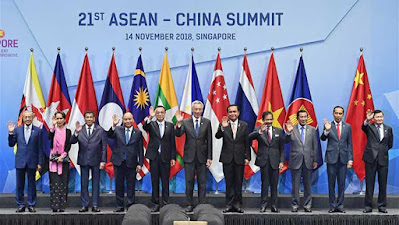Xinhua News: China, ASEAN move forward amid changes
BALI, Indonesia, Nov. 17 (Xinhua) -- As China and ASEAN are going to celebrate their 20th anniversary of dialogue at a commemorative summit in the Indonesian resort island of Bali this week, China-ASEAN relations have all evolved to a stage better than ever.
ASEAN, the then 6-member bloc, is dubbed now as the growth engine for the world and China, who just began economic reforms toward a market economy in those days, ranks the 2nd largest economy. Their relations also prove to emerge stronger from all the changes they encountered over the period.
The year of 1997 is the watershed in the history of China and ASEAN relations. Despite its own financial difficulties, China resisted pressures to depreciate its currency renminbi and offered more than 4-billion-U.S. dollar assistance and export credit to help Southeast Asian countries to recover,which later resulted in the establishment of good-neighborly and mutual-trust partnership. Both sides also signed an initial framework in 2002 to build a Free Trade Area (FTA).
In the face of the following 2008 international financial crisis, they did not retreat but signed the crucial investment agreement on the FTA, to join hands to combat the crisis and promote free trade and investment. With the FTA coming into effect in 2010, it boosted trade among the 11 nations while cushioning the slowing demand from the traditional export destinations of Europe and the United States.
ASEAN and China have been cooperating on 11 priority areas of cooperation, namely agriculture, information and communication technology, human resource development, Mekong Basin Development, investment, energy, transport, culture, public health, tourism and environment.
Looking back at their cooperation, Dr. Sri Adiningsih, the co- founder of the Asia Pacific Studies at the Gadjah Mada university, said that the ASEAN+1, +3 and +6 have greatly complemented the ASEAN economies and respective dialogue partners. "China has been acting as the axis of economy in East Asia (and)would be the backbone of the world's economy ..so it is very important to make ASEAN get along with China in attaining growth in the eve of global economy awakening."
The China-ASEAN's FTA, the largest of its kind embracing developing countries, boasts a combined GDP of nearly six trillion U.S. dollars and a trade volume of 4.5 trillion U.S. dollars. The FTA enabled bilateral trade volume to reach 292.8 billion U.S. dollars in 2010, in sharp contrast to the less than 8 billion U.S. dollars trade in 1990.
In the first 10 months of this year, the figure stood at 295.9 billion U.S. dollars. China became the largest trade partner for ASEAN and ASEAN, the third largest partner of China.
According to Adiningsih, Indonesian consumers can now buy Chinese products at affordable prices, complete the utensils in their houses with electronics and household products from China. Indonesian raw materials and natural resource-commodity producers were also enjoying robust business from the FTA.
But she also cautioned the Indonesia small-and-medium sized enterprises to improve efficiency and competitiveness, otherwise they will not be "growing side by side with China."
Addressing the similar concerns, Chinese Premier Wen Jiabao said before his Malaysia and Indonesia trip in April that China and ASEAN should constantly improve this arrangement in the light of actual circumstances, accommodate the interests of small- and medium-sized enterprises, and work together to ensure that the FTA will contribute to the economic development of all sides.
Apart from the fruitful economic ties, China and ASEAN also forged ahead in politics and security. China was the first country outside ASEAN to sign the ASEAN Treaty of Amity and Cooperation, to establish the strategic partnership for peace and prosperity, to discuss FTA with ASEAN and the first to back the Southeast Nuclear-Weapon-Free Zone Treaty.
With the worsening European debt crisis and mounting debt load weighing on the U.S. Economy, the U.S. and Russia joining the East Asia Summit for the first time, China and ASEAN face new international and regional landscape to develop their relations.
Bank of China President Li Lihui said earlier that China and ASEAN should promote cross-border yuan settlement, reducing exchange rate risk and boosting trade and investment in ASEAN, which was one of the first overseas trials of cross-border trade settlement in yuan since July 2009.
"We are witnessing improved relations between ASEAN and China against the new external backdrop," Tjhin said, adding "the fact that China acknowledges ASEAN centrality in regional institutional building is a respectable move. A more institutionalized dialogue between ASEAN and China is the key to fortify ties."
ASEAN and China continued to enhance their close and strategic partnership through regular dialogue and consultations, such as ASEAN-China Summit, ASEAN-China Ministerial Meeting. ASEAN-China Senior Officials Consultations, and other related meetings on bilateral, regional and global issues of common interests and concerns. China supports ASEAN's role as the driving force of the regional processes initiated by ASEAN such as ASEAN Plus Three ( APT), ASEAN Regional Forum (ARF), ASEAN Defence Ministers' Meeting Plus (ADMM-Plus) and East Asia Summit (EAS).
China is the first dialogue partner of ASEAN to accede to the Treaty of Amity and Cooperation (TAC) in Southeast Asia at the 7th ASEAN-China Summit in October 2003 in Bali, Indonesia.




Komentar
Posting Komentar